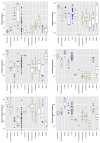In vivo baseline measurements of hip joint range of motion in suspensory and nonsuspensory anthropoids
- PMID: 24288178
- PMCID: PMC4023689
- DOI: 10.1002/ajpa.22440
In vivo baseline measurements of hip joint range of motion in suspensory and nonsuspensory anthropoids
Abstract
Hominoids and atelines are known to use suspensory behaviors and are assumed to possess greater hip joint mobility than nonsuspensory monkeys, particularly for range of abduction. This assumption has greatly influenced how extant and fossil primate hip joint morphology has been interpreted, despite the fact that there are no data available on hip mobility in hominoids or Ateles. This study uses in vivo measurements to test the hypothesis that suspensory anthropoids have significantly greater ranges of hip joint mobility than nonsuspensory anthropoids. Passive hip joint mobility was measured on a large sample of anesthetized captive anthropoids (nonhuman hominids = 43, hylobatids = 6, cercopithecids = 43, Ateles = 6, and Cebus = 6). Angular and linear data were collected using goniometers and tape measures. Range of motion (ROM) data were analyzed for significant differences by locomotor group using ANOVA and phylogenetic regression. The data demonstrate that suspensory anthropoids are capable of significantly greater hip abduction and external rotation. Degree of flexion and internal rotation were not larger in the suspensory primates, indicating that suspension is not associated with a global increase in hip mobility. Future work should consider the role of external rotation in abduction ability, how the physical position of the distal limb segments are influenced by differences in ROM proximally, as well as focus on bony and soft tissue differences that enable or restrict abduction and external rotation at the anthropoid hip joint.
Keywords: external rotation; hip abduction; orthogrady; passive joint mobility; primates.
Copyright © 2013 Wiley Periodicals, Inc.
Figures




Similar articles
-
A validated method for modeling anthropoid hip abduction in silico.Am J Phys Anthropol. 2016 Jul;160(3):529-48. doi: 10.1002/ajpa.22990. Epub 2016 Apr 18. Am J Phys Anthropol. 2016. PMID: 27088216
-
Hip joint mobility in free-ranging rhesus macaques.Am J Phys Anthropol. 2017 Feb;162(2):377-384. doi: 10.1002/ajpa.23112. Epub 2016 Oct 12. Am J Phys Anthropol. 2017. PMID: 27731892 Free PMC article.
-
Soft tissue influence on ex vivo mobility in the hip of Iguana: comparison with in vivo movement and its bearing on joint motion of fossil sprawling tetrapods.J Anat. 2014 Jul;225(1):31-41. doi: 10.1111/joa.12187. Epub 2014 Apr 25. J Anat. 2014. PMID: 24762236 Free PMC article.
-
Hip Range of Motion During Passive and 1-Leg Exercises Is Greater in Women: A Meta-analysis and Systematic Review.Arthroscopy. 2024 Feb;40(2):495-512.e3. doi: 10.1016/j.arthro.2023.04.006. Epub 2023 Apr 26. Arthroscopy. 2024. PMID: 37116553
-
The envelope of active hip motion in different sporting, recreational, and daily-living activities: A systematic review.Gait Posture. 2019 Jun;71:227-233. doi: 10.1016/j.gaitpost.2019.05.006. Epub 2019 May 2. Gait Posture. 2019. PMID: 31078827
Cited by
-
A 3D musculoskeletal model of the western lowland gorilla hind limb: moment arms and torque of the hip, knee and ankle.J Anat. 2017 Oct;231(4):568-584. doi: 10.1111/joa.12651. Epub 2017 Jul 17. J Anat. 2017. PMID: 28718217 Free PMC article.
-
Three-dimensional kinematics and the origin of the hominin walking stride.J R Soc Interface. 2018 Aug;15(145):20180205. doi: 10.1098/rsif.2018.0205. J R Soc Interface. 2018. PMID: 30089686 Free PMC article.
-
Trabecular architecture of the distal femur in extant hominids.J Anat. 2024 Jul;245(1):156-180. doi: 10.1111/joa.14026. Epub 2024 Feb 21. J Anat. 2024. PMID: 38381116 Free PMC article.
-
Trabecular Architecture of the Proximal Tibia in Extant Hominids.Am J Biol Anthropol. 2025 Jul;187(3):e70084. doi: 10.1002/ajpa.70084. Am J Biol Anthropol. 2025. PMID: 40583737 Free PMC article.
-
Trabecular architecture of the great ape and human femoral head.J Anat. 2019 May;234(5):679-693. doi: 10.1111/joa.12957. Epub 2019 Feb 21. J Anat. 2019. PMID: 30793309 Free PMC article.
References
-
- Anapol F, Barry K. Fiber architecture of the extensors of the hindlimb in semiterrestrial and arboreal guenons. Am J Phys Anthropol. 1996;99(3):429–447. - PubMed
-
- Arnold C, Matthews LJ, Nunn CL. The 10kTrees Website: A New Online Resource for Primate Phylogeny. Evol Anthropol. 2010;19:114–118.
-
- Avis V. Brachiation: the crucial issue for Man’s ancestry. S J Anthropol. 1962;18(2):119–148.
-
- Bardakos NV, Villar RN. The ligamentum teres of the adult hip. J Bone Joint Surg Br. 2009;91(1):8–15. - PubMed
Publication types
MeSH terms
Grants and funding
LinkOut - more resources
Full Text Sources
Other Literature Sources

